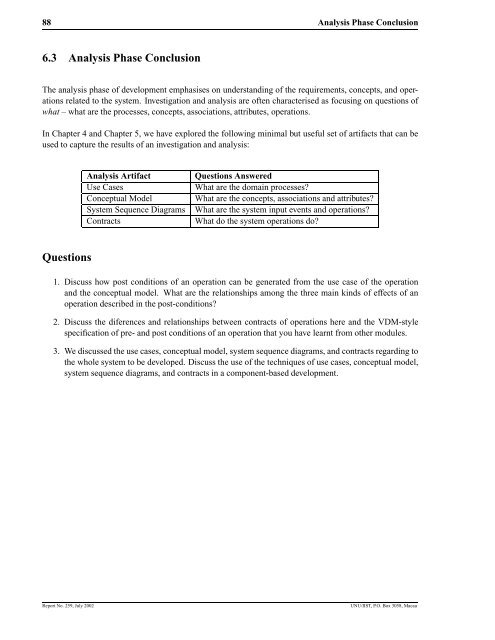Object-Oriented Software Development with UML - UNU-IIST ...
Object-Oriented Software Development with UML - UNU-IIST ...
Object-Oriented Software Development with UML - UNU-IIST ...
Create successful ePaper yourself
Turn your PDF publications into a flip-book with our unique Google optimized e-Paper software.
88 Analysis Phase Conclusion6.3 Analysis Phase ConclusionThe analysis phase of development emphasises on understanding of the requirements, concepts, and operationsrelated to the system. Investigation and analysis are often characterised as focusing on questions ofwhat – what are the processes, concepts, associations, attributes, operations.In Chapter 4 and Chapter 5, we have explored the following minimal but useful set of artifacts that can beused to capture the results of an investigation and analysis:Analysis ArtifactUse CasesConceptual ModelSystem Sequence DiagramsContractsQuestions AnsweredWhat are the domain processes?What are the concepts, associations and attributes?What are the system input events and operations?What do the system operations do?Questions1. Discuss how post conditions of an operation can be generated from the use case of the operationand the conceptual model. What are the relationships among the three main kinds of effects of anoperation described in the post-conditions?2. Discuss the diferences and relationships between contracts of operations here and the VDM-stylespecification of pre- and post conditions of an operation that you have learnt from other modules.3. We discussed the use cases, conceptual model, system sequence diagrams, and contracts regarding tothe whole system to be developed. Discuss the use of the techniques of use cases, conceptual model,system sequence diagrams, and contracts in a component-based development.Report No. 259, July 2002<strong>UNU</strong>/<strong>IIST</strong>, P.O. Box 3058, Macau
















